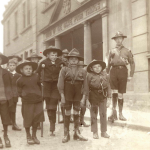The team in Liverpool recently attended Visual Impairment Awareness training delivered by St Vincent’s School. It was intended to give us an awareness of visual impairment and increase our confidence when working with young people at film workshops this summer. The phrase we heard a number of times was ’empathy not sympathy’ meaning we could gain an understanding of what life is like for people with a visual impairment and some of the mobility and orientation activities the students at the school take part in to equip them with the skills to live independently but no sympathy is needed or invited. Ellis Gould, who was completing work experience in the Archaeology Department at the Museum of Liverpool, also took part and shares her thoughts with us:

Ellis taking part in a mobility activity using the method the students use to safely walk around school
Last week I was taking part in work experience in the Archaeology Department at the Museum of Liverpool. I had the opportunity to receive visual impairment training at St Vincent’s School for the Sensory Impaired in West Derby, Liverpool. I took part in the training alongside volunteers on the History of Place project who is working with the school this summer on a film project.
Being given the opportunity to spend the day at the school beforehand allowed us to get a whole new insight into the lives of those with visual
impairments. We were able to participate in a number of activities that would allow us to experience daily routines from the perspective of a person with a visual impairment, as well as the routines and responsibilities of those who provide their assistance and care to those with visual impairments who may need or want it. These activities ranged from being educated on how to correctly guide those who may require help, as well as being able to experience ourselves how to carry out activities without our sight, from everyday events such as moving around and counting out money, to reading a book and preparing food. We were also given the chance to learn about how technology is also able to provide assistance, such as with identifying notes and measuring liquid levels, and the evolution of the appearance and use of canes.
For myself, it was certainly an experience that will register with me for a long
time to come. Not only did I find myself with a whole new education concerning people who are visually impaired, but also a great deal of empathy, and even more appreciation for people with a visual impairment. St Vincent’s is an amazing place, able to provide its students with what seemed to be almost every possibility imaginable, from music to sport, languages to art and so much more. It is not only open in terms of space, but also in the general, positive atmosphere of both the staff and the pupils.
The best of wishes go to History of Place in the rest of their journey, and a big thank you to St Vincent’s for being so welcoming.
Ellis Gould













